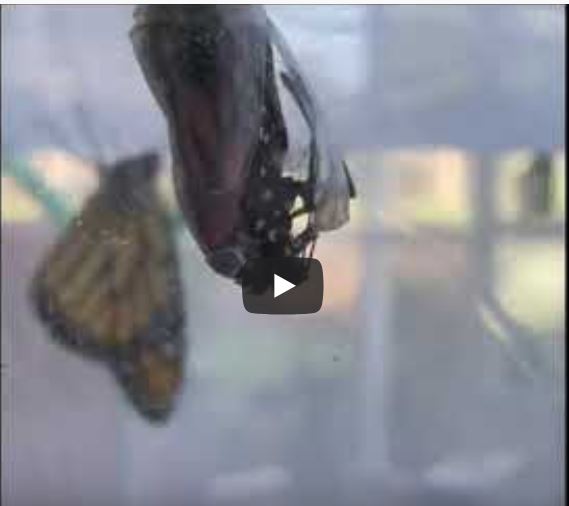
Paula Massey, August 2021
I love to garden and over the years have planted mostly native plants, and therefore have created a pollinator garden to attract birds, bees, and butterflies. So, I had the good fortune mid-August of finding Monarch caterpillars feasting on my two Milkweed plants-the only plant that Monarch caterpillars will eat. And having learned the hard way that there are big wasps and very large aphids that like to feast on butterfly caterpillars, I gathered “my caterpillars” along with branches of the Swamp Milkweed and placed them in my butterfly habitat.
So began my role as their doula, and what a joyful experience it has been! I witnessed the cycles of their life, from hungry and then restless caterpillars, as they selected their spot to attach to the netting and literally hang upside down. I was so lucky to witness the next phase as they made their own chrysalis, (outer shell), in the transition to the pupa phase. And then in 7 days they began to emerge (enclose), as the chrysalis would literally split down the middle and the fully formed adult butterfly would drop down and begin to untangle its body parts. I had read that this is a vulnerable time, so I gave them 3-4 hours to dry off and begin slowly moving around and flapping their wings. It was then that I would open the habitat and carefully assist them outside. Some gave me the gift of a slow farewell by landing on my flowers, but most were eager to begin their journey and just flew high up into the sky. That was always a bittersweet moment.
 So, what have I learned since I decided to add Milkweed to my small pollinator garden? I have found out that 90% of the Monarch population has declined, and continues to do so, in part due to increased land development and clearing of their habitat. If everyone in our community would just plant one Swamp Milkweed plant (the variety that can be found along the shoreline and drainage ponds), along with a couple of late summer blooming flowers like a butterfly bush and coneflowers in your yard, we will be able to attract the adult butterflies and have a positive impact on our Monarch population. This in fact is called the Monarch Effect-small actions have a big impact when we work together.
So, what have I learned since I decided to add Milkweed to my small pollinator garden? I have found out that 90% of the Monarch population has declined, and continues to do so, in part due to increased land development and clearing of their habitat. If everyone in our community would just plant one Swamp Milkweed plant (the variety that can be found along the shoreline and drainage ponds), along with a couple of late summer blooming flowers like a butterfly bush and coneflowers in your yard, we will be able to attract the adult butterflies and have a positive impact on our Monarch population. This in fact is called the Monarch Effect-small actions have a big impact when we work together.
Let’s try to preserve their habitat at Lake Robinson by planting native plants and grasses. It will not only encourage more Monarch butterflies, but it will add even more beauty to our lakeside community.
I am happy to lead the effort to plant native wildflowers, including the Swamp Milkweed and the Ironweed, along with other late summer bloomers to encourage wildlife to flourish along our shoreline and throughout our community. In the meantime, please enjoy the pictures and know that I would be happy to show you the plants in my pollinator garden that are easy to grow and very popular with these valuable pollinators and don’t take up a lot of your space or time. Of course, if you too want to become a doula next year, then the fun really begins!
Watch this 3-minute video filmed by Sue Fitzgerald

